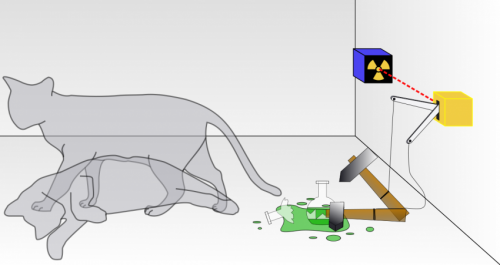Schrödinger's cat: a cat, a flask of poison, and a radioactive source are placed in a sealed box. If an internal monitor detects radioactivity (i.e. a single atom decaying), the flask is shattered, releasing the poison that kills the cat. The Copenhagen interpretation of quantum mechanics implies that after a while, the cat is simultaneously alive and dead. Yet, when one looks in the box, one sees the cat either alive or dead, not both alive and dead. This poses the question of when exactly quantum superposition ends and reality collapses into one possibility or the other. Credit: Wikipedia / CC BY-SA 3.0
Physicists have learned how they could breed Schrödinger cats in optics. Scientists tested a method that could potentially amplify superpositions of classical states of light beyond microscopic limits and help determine the boundaries between the quantum and classical worlds.
CIFAR Quantum Information Science Fellow Alexander Lvovsky led the team of Russian Quantum Center and University of Calgary scientists who tested a method that could potentially amplify superpositions of classical states of light beyond microscopic limits and help determine the boundaries between the quantum and classical worlds.
The study was published today in Nature Photonics.
In 1935, German physicist Erwin Schrödinger proposed a thought experiment where a cat, hidden from the observer, is in a superposition of two states: it was both alive and dead. Schrödinger's cat was intended to show how radically different the macroscopic world we see is from the microscopic world governed by the laws of quantum physics.
However, the development of quantum technologies makes it possible to create increasingly complex quantum states, and Schrödinger's thought experiment no longer seems too far out of reach.
"One of the fundamental questions of physics is the boundary between the quantum and classical worlds. Can quantum phenomena, provided ideal conditions, be observed in macroscopic objects? Theory gives no answer to this question—maybe there is no such boundary. What we need is a tool that will probe it," says Lvovsky, who is a professor at the University of Calgary and head of the Quantum Optics Laboratory of the Russian Quantum Center, where the experiment was set up.
Exactly such a tool is provided by the physical analogue of the Schrödinger cat - an object in a quantum superposition of two states with opposite properties. In optics, this is a superposition of two coherent light waves where the fields of the electromagnetic waves point in two opposite directions at once. Until now, experiments could only obtain such superpositions at small amplitudes that limit their use. The Lvovsky group carried out the procedure of "breeding" such states, which makes it possible to obtain optical "cats" of higher amplitudes with greater success.
Co-author and University of Calgary graduate student Anastasia Pushkina explains: "The idea of the experiment was proposed in 2003 by the group of Professor Timothy Ralph of the University of Queensland, Australia. In essence, we cause interference of two "cats" on a beam splitter. This leads to an entangled state in the two output channels of that beam splitter. In one of these channels, a special detector is placed. In the event this detector shows a certain result, a "cat" is born in the second output whose energy is more than twice that of the initial one."
The Lvovsky group tested this method in the lab. In the experiment, they successfully converted a pair of negative squeezed "Schrodinger cats" of amplitude 1.15 to a single positive "cat" of amplitude 1.85. They generated several thousand such enlarged "cats" in their experiment.
"It is important that the procedure can be repeated: new 'cats' can, in turn, be overlapped on a beam splitter, producing one with even higher energy, and so on. Thus, it is possible to push the boundaries of the quantum world step by step, and eventually to understand whether it has a limit," says the first author of the study, a graduate student from the Russian Quantum Center and the Moscow State Pedagogical University, Demid Sychev.
Such macroscopic "Schrodinger cats" would have applications in quantum communication, teleportation and cryptography.
More information: Cultivation of optical Schrödinger's cat states, Nature Photonics (2017). nature.com/articles/doi:10.1038/nphoton.2017.57
Journal information: Nature Photonics
Provided by Canadian Institute for Advanced Research























